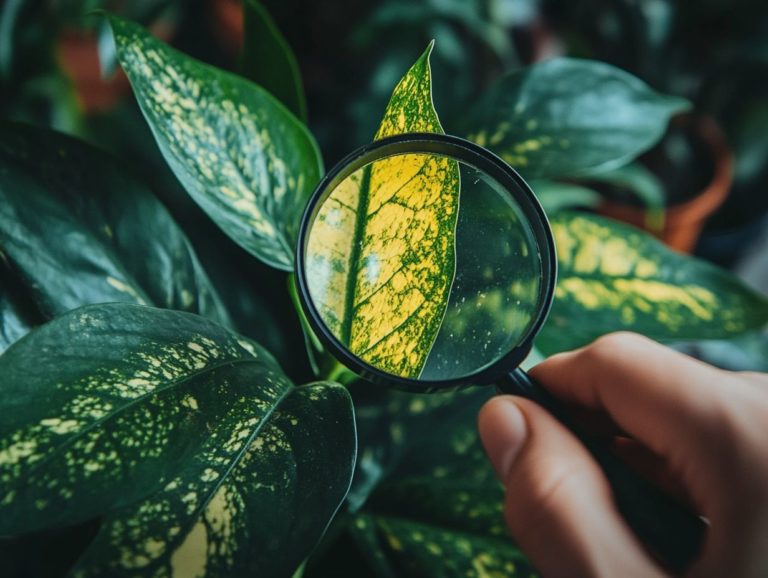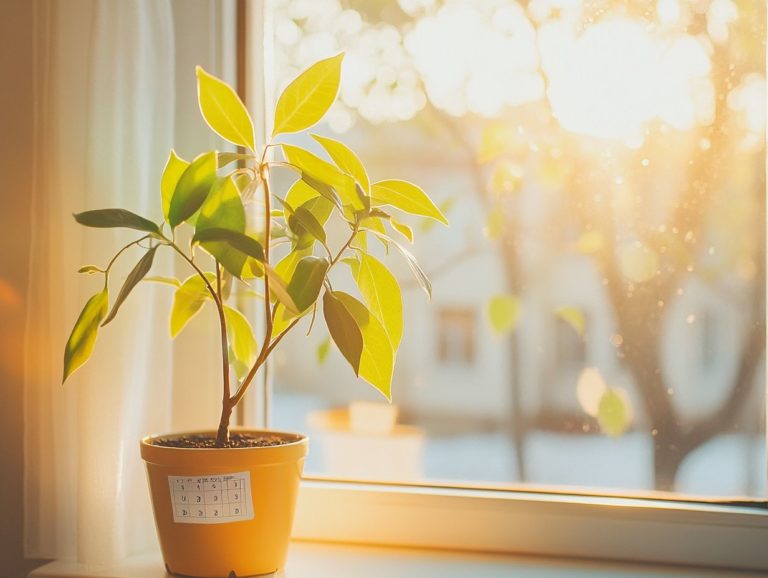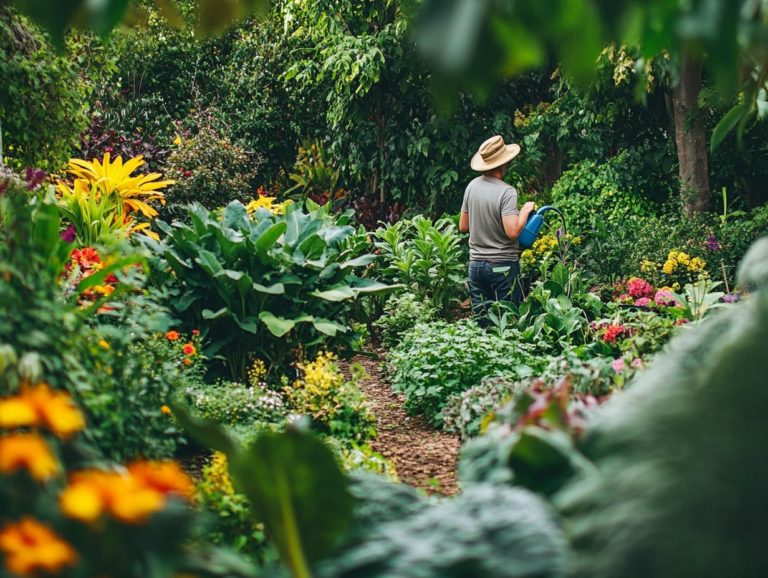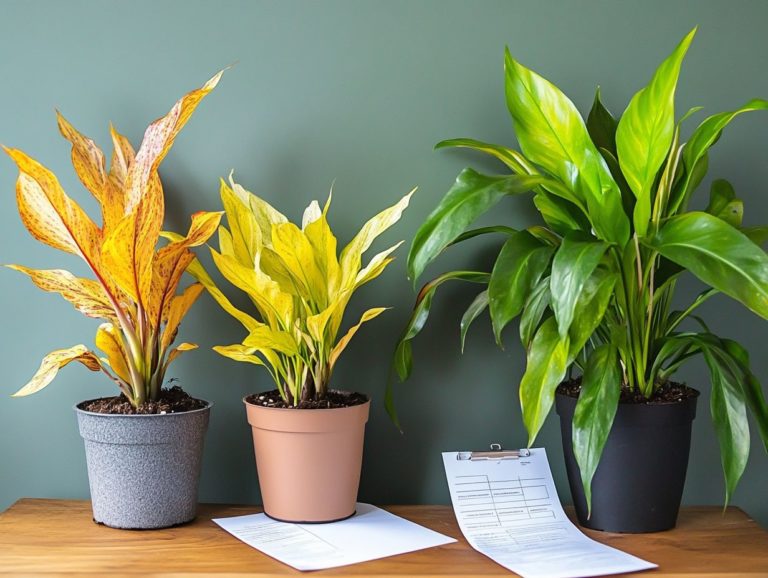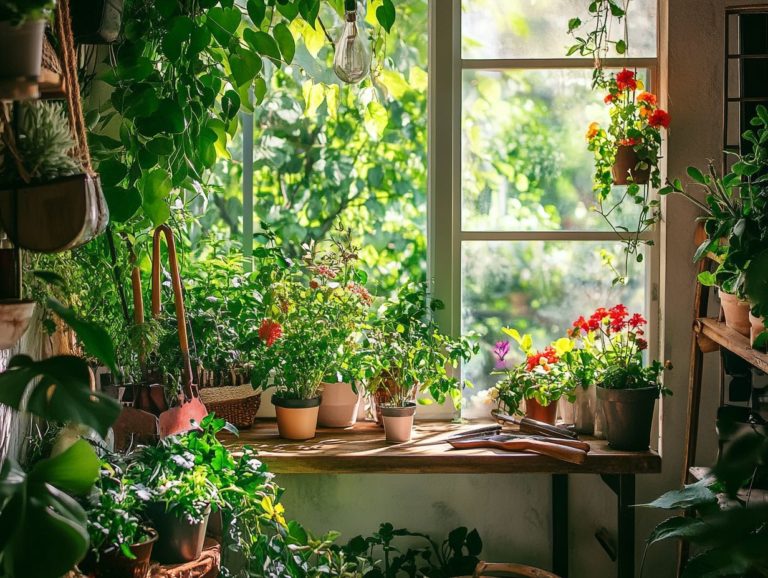Top 10 Urban Myths About Indoor Plant Pests
Indoor plants infuse your spaces with life and vibrancy, yet they aren t exempt from the nuisances of pests.
A cloud of misconceptions often surrounds these unwelcome visitors, creating confusion and leading to ineffective treatments. You might think that only neglected plants attract pests or believe that pesticides are the one-size-fits-all solution. These urban legends can feel overwhelming at times.
This article sets the record straight by debunking the top 10 myths about indoor plant pests, revealing the truth and offering practical tips to help you maintain a thriving indoor garden.
Contents
- Key Takeaways:
- 1. Myth #1: Indoor Plants Don’t Get Pests
- 2. Myth #2: Only Dirty Plants Attract Pests
- 3. Myth #3: Pests Only Come from Outside
- 4. Myth #4: Pesticides Are the Only Solution
- 5. Myth #5: Pests Only Target Specific Plants
- 6. Myth #6: Pests Don’t Spread Between Plants
- 7. Myth #7: Pests Can Be Easily Identified
- 8. Myth #8: Natural Repellents Always Work
- 9. Myth #9: Pests Only Affect Leaves
- 10. Myth #10: Pests Don’t Affect Indoor Air Quality
- How Do Pests Get into Indoor Plants?
- Frequently Asked Questions
- 1. What are the top 10 urban myths about indoor plant pests?
- 2. Are all insects found on houseplants harmful?
- 3. Do plant pests only affect certain types of plants?
- 4. Is using pesticides the best way to get rid of plant pests?
- 5. Do indoor plants not attract pests?
- 6. Can overwatering plants prevent pests and promote pest awareness?
Key Takeaways:
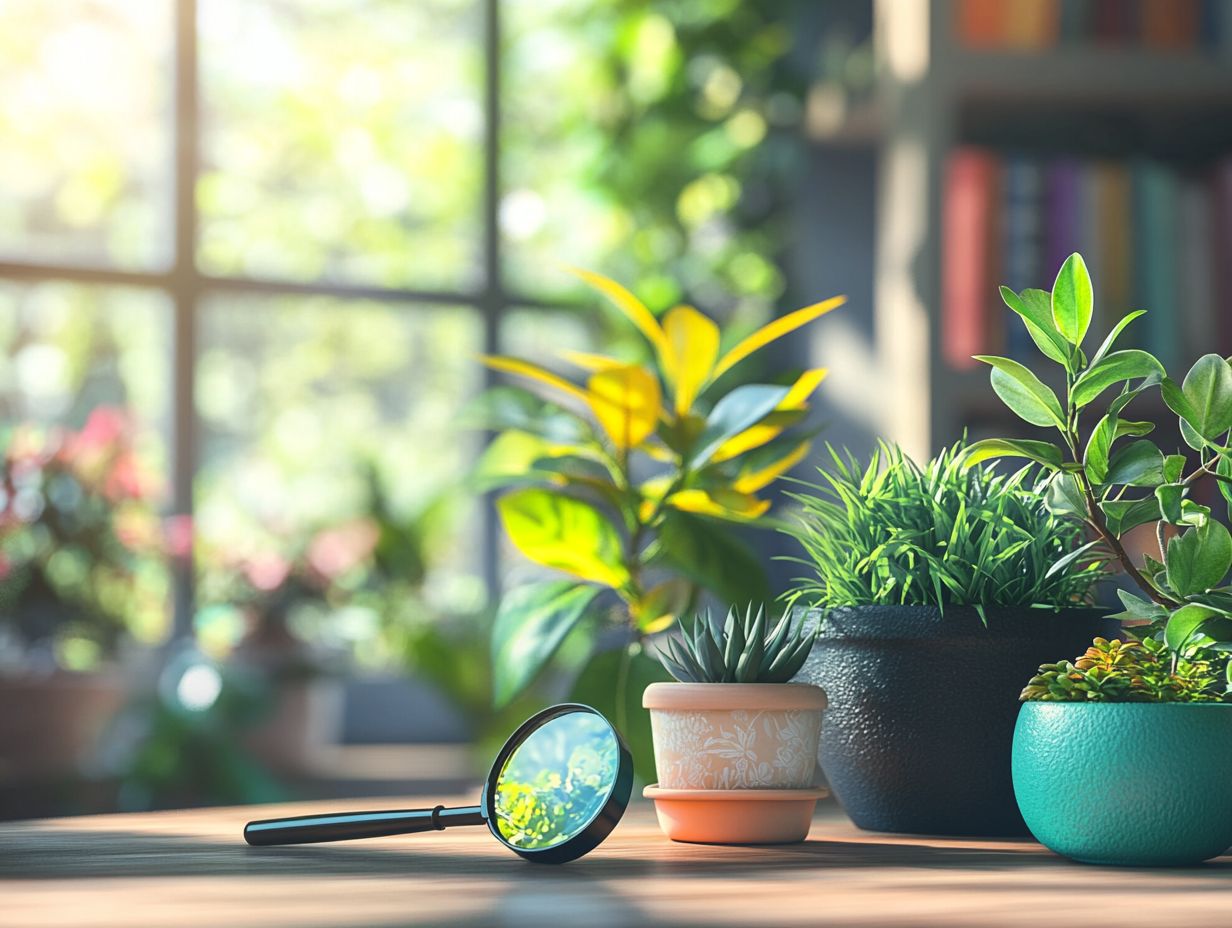
- Indoor plants are not immune to pests, so regular monitoring and proper care are necessary to prevent infestations.
- Cleanliness is important, but it doesn’t guarantee a pest-free environment for indoor plants. Pests can come from different sources, not just dirt or debris.
- Pests can easily spread from outdoor plants to indoor ones, so it’s important to regularly check and quarantine new plants before introducing them to your collection.
1. Myth #1: Indoor Plants Don’t Get Pests
Indoor plants, contrary to popular belief, are not immune to the clutches of houseplant pests. Common invaders like aphids, mealybugs, and spider mites can wreak havoc on your plants’ health if not managed promptly.
It s a widespread myth that houseplants are safe from pest infestations. Understanding these pests’ habits and lifecycles is essential for truly effective plant care.
Many houseplant owners often overlook the importance of proactive pest management. This can lead to significant issues later on. By implementing simple pest control methods that focus on pest identification and ecological approaches, you can tackle infestations early.
Regularly inspecting your plants allows you to catch subtle signs of trouble before they escalate. This ensures healthier foliage and vibrant greens.
By staying vigilant and adopting a few simple practices, you can effectively ward off pests and cultivate a more harmonious indoor environment for your leafy companions.
2. Myth #2: Only Dirty Plants Attract Pests
It s a common misconception that only dirty plants attract pests. The reality is that even your most pristine indoor plants can become targets due to various environmental factors.
Consider elements such as humidity, temperature, and airflow; they play a pivotal role in creating an environment that can either repel or invite pests.
For instance, high humidity can turn into a breeding ground for these unwelcome visitors, while stagnant air might just roll out the red carpet for infestations.
These conditions can lure pests to any plant, regardless of its immaculate appearance. This highlights the necessity of focusing on the overall environment.
Even the healthiest plant can still attract pests if conditions are favorable for their survival and reproduction. Therefore, blend plant cleanliness with smart environmental controls for effective pest prevention.
3. Myth #3: Pests Only Come from Outside
Many plant owners assume that pests only invade their homes from the great outdoors. The truth is, indoor gardening can be a hidden sanctuary for a variety of pests, including spider mites and whiteflies.
These unwelcome guests might already be lurking in the soil or on the plants themselves. This problem can surprise many plant owners, especially when sourcing plants from nurseries or garden centers, where they may have encountered infestations before making their way to your home.
Regularly monitoring your plants is key. By inspecting both the foliage and soil consistently, you can catch the early signs of an infestation.
This proactive approach allows you to address pests swiftly, preventing them from spreading and wreaking havoc on your beloved plants.
Start monitoring your indoor plants today to keep them healthy and pest-free!
4. Myth #4: Pesticides Are the Only Solution
A common misconception is that your only option for tackling pests is to reach for harsh insecticides. However, you have a wealth of organic pest control techniques and natural remedies at your disposal that can effectively manage houseplant pests without harming the environment or beneficial insects.
Among these methods, integrated pest management (IPM) a method that combines different techniques to control pests truly shines as a holistic approach. It combines biological, cultural, and mechanical strategies to minimize pest issues while promoting ecological balance.
You might consider introducing beneficial insects, like ladybird beetles and green lacewings. These insects are natural predators of aphids and other pesky invaders.
By fostering a diverse ecosystem, you can protect your indoor garden and reduce your reliance on traditional pesticides. Embracing these gentle yet effective methods not only leads to a more sustainable gardening practice but also harnesses nature’s own defenses against the pests threatening your plants’ health.
5. Myth #5: Pests Only Target Specific Plants
It s a common myth that certain pests only target specific plants. In reality, many houseplant pests, such as scale insects and aphids, can infest a wide array of indoor plants and even vegetables in your garden.
These adaptable pests thrive in various environments and can present significant challenges for anyone caring for plants. Take scale insects, for example they can latch onto both succulents and flowering plants, siphoning off vital nutrients and ultimately harming the health of your plants.
Similarly, aphids are infamous for their rapid reproduction and ability to affect a diverse range of species, from houseplants to herbs. This adaptability makes pest care a dynamic challenge!
It is essential for you to adopt a proactive approach to pest management. Regular monitoring and employing integrated pest management strategies are crucial in safeguarding the health of your plants.
6. Myth #6: Pests Don’t Spread Between Plants

Many plant owners might think pests can’t spread from one plant to another, but the truth is quite different. Pest populations can escalate rapidly, infesting multiple indoor plants if you don’t tackle the issue with effective pest management strategies.
Pests like mealybugs and spider mites can easily hop from plant to plant through direct contact or contaminated tools and hands. This highlights the importance of conducting regular inspections to spot any signs of these unwelcome intruders.
If you suspect an infestation, isolating affected plants is crucial to prevent further spread. Ensuring good air circulation, regularly cleaning leaves, and using organic insecticidal soaps are effective preventative measures to safeguard your cherished indoor garden.
By staying vigilant and proactive, you can save yourself time and trouble in the long run.
7. Myth #7: Pests Can Be Easily Identified
While some pests are easy to spot, many houseplant nuisances can be quite elusive, leading to misdiagnoses and less-than-effective treatments. This challenge intensifies due to the various life stages these pests can exhibit.
For example, an insect may appear drastically different in its larval stage compared to its adult form, adding layers of complexity to the identification process. Some pests even share similar characteristics, making it even trickier to tell them apart.
To improve your accuracy, it s essential to get familiar with the common pests that target houseplants and to recognize the signs they leave behind, like webbing or leaf damage. Being aware of these differences is vital, as accurate identification forms the foundation for effective management strategies.
By ensuring that you can implement the right treatments without delay, you ll keep your plants healthy and thriving!
8. Myth #8: Natural Repellents Always Work
Natural repellents are often praised as foolproof solutions for pest control. However, their effectiveness can vary greatly based on the type of pest and the environmental conditions.
Factors like humidity, temperature, and competing scents significantly affect how well these organic alternatives perform. For instance, certain herbal oils may effectively deter mosquitoes in ideal weather but lose their potency in rain or extreme heat.
Relying solely on natural methods may not yield the results you hope for, especially with persistent infestations.
Act now to combine these natural techniques with more conventional pest management strategies. This combined approach boosts your chances of success and supports an environmentally conscious ethos in your pest control practices.
9. Myth #9: Pests Only Affect Leaves
Many plant owners mistakenly believe that pests target only the leaves of their plants. In reality, these nuisances can also damage roots and stems, compromising your plants’ health.
The hidden damage from these unwelcome guests can impede nutrient absorption and stunt growth, leading to weakened plants that are more prone to stress. Some pests even act as pests that spread diseases, quickly spreading pathogens that manifest as wilting, discoloration, or the untimely demise of your plants.
To protect your botanical companions, embrace comprehensive care practices. Regularly monitor for signs of infestation and take proactive measures to ensure your plants thrive. By nurturing them from root to leaf, you enhance their resilience and keep them flourishing beautifully.
10. Myth #10: Pests Don’t Affect Indoor Air Quality
Many people believe incorrectly that pests don t affect indoor air quality. In reality, infestations can lead to mold growth and other issues that compromise the air you breathe.
When pests invade your space, they cause structural damage and create a breeding ground for allergens. For example, the droppings and shed skins of rodents can trigger allergic reactions. Cockroach waste has been linked to worsening asthma symptoms. Additionally, the moisture introduced by these infestations can encourage mold growth, releasing spores into the air and worsening respiratory issues.
To maintain a healthy indoor environment, control moisture levels, engage in regular cleaning, and implement effective pest management strategies. By taking these steps, you can prevent infestations before they start, ensuring both your well-being and the quality of the air you breathe.
How Do Pests Get into Indoor Plants?
Understanding how pests infiltrate your indoor plants is essential for effective pest management. They can enter through various avenues, such as new plants, contaminated soil, and even your gardening tools.
Be aware of these entry points to take proactive measures against infestations. When purchasing new plants, source them from reputable suppliers and inspect them meticulously for signs of pests. Treating or sterilizing soil before introducing it to your existing plants adds an extra layer of protection against hidden threats.
Regular maintenance and careful inspection of your gardening tools are equally important, as these items can transport unwanted pests from one area to another. By adopting a vigilant approach, you can enhance the health and longevity of your indoor plant collection.
What Are the Most Common Types of Indoor Plant Pests?
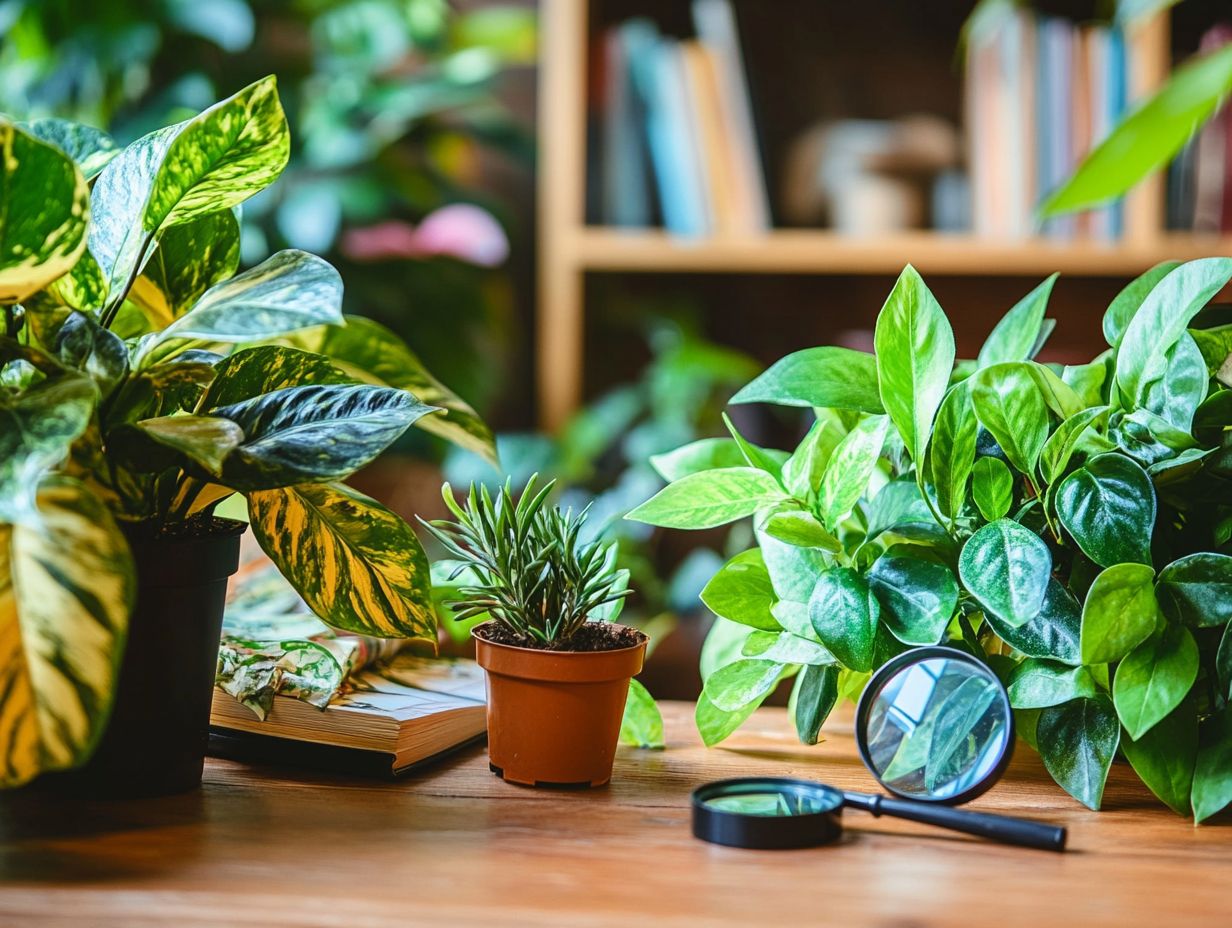
Indoor gardeners often face a variety of common pests, including aphids, mealybugs, spider mites, and whiteflies. Each presents unique challenges for identification and control.
These tiny invaders can truly wreak havoc on your cherished plants, leading to stunted growth and unsightly damage. For example, aphids tend to gather in clusters on fresh new growth. Mealybugs leave behind a telling white, cottony residue. Spider mites, known for their fine webs, can often be found lurking on the undersides of leaves, particularly in dry conditions. To identify and manage these pests, check out what are the most common indoor plant pests. Meanwhile, whiteflies are easily recognizable by their small, white, moth-like appearance and the sticky residue they leave in their wake.
To combat these pests effectively, consider implementing a range of targeted strategies. Introducing natural predators, using insecticidal soap, or applying neem oil can all prove beneficial, depending on the specific infestation at hand.
What Are the Signs of Pest Infestation in Indoor Plants?
Spotting pest infestations quickly is crucial for saving your plants! Keep an eye out for indicators like yellowing leaves or the presence of visible insects.
Have you noticed sticky residue on your leaves? It might be time to investigate! Other common symptoms to watch for include stunted growth, sticky residue on leaves, or webbing often a telltale sign of spider mites. Discolored or dropping leaves could indicate larger issues, suggesting poorly managed conditions.
Regularly monitoring your plants not only promotes vibrant growth but also allows you to adopt preventive measures. This ensures any signs of trouble don t spiral out of control. By cultivating awareness about these symptoms, you empower yourself to act swiftly, protecting your plants from further damage and preserving their health and beauty.
How Can Indoor Plant Pests Be Prevented?
Effective pest prevention strategies are critical for keeping your indoor plants healthy. You can utilize integrated pest management techniques, which means using a mix of methods to keep pests away.
Establish a routine that includes regular inspections of your plants. This helps catch potential infestations early and prevents them from spreading. Additionally, it’s important to debunk any misconceptions you may have; for example, knowing what the common myths about indoor plants are can aid in ensuring proper soil care, like avoiding overwatering, which tends to attract unwanted insects.
Maintaining an environment that supports plant health, adjusting humidity levels, and ensuring adequate air circulation can significantly deter pest populations. When you combine these measures, you create a formidable defense against pests, contributing to vibrant, thriving indoor greenery. It’s also important to be aware of common misconceptions; check out the top indoor plant pest myths debunked to enhance your pest management strategies.
What Are the Non-Toxic Ways to Get Rid of Indoor Plant Pests?
If you want non-toxic solutions, there are several effective strategies to remove indoor plant pests. You can try natural insecticides, such as neem oil, or try introducing beneficial insects.
These methods not only safeguard your plants but also maintain the integrity of your indoor environment by steering clear of harmful chemicals. Many have discovered that introducing ladybugs or predatory mites can drastically reduce pest populations without any negative side effects. To further enhance your pest management strategies, consider learning about the top 5 most destructive indoor plant pests.
Additionally, you might find that a homemade solution of soap and water acts as a gentle deterrent against common nuisances like aphids and spider mites. To make this solution, mix a few drops of liquid soap with water in a spray bottle. Regularly inspecting your plants and maintaining optimal humidity levels can also help create an unwelcoming atmosphere for pests. For more insights, check out understanding indoor plant pests and their impact, ultimately fostering healthier growth all around.
In conclusion, being proactive in pest management not only protects your indoor plants but also fosters a thriving environment. For those looking for effective solutions, consider the top 5 natural remedies for houseplant pests. Stay vigilant, act quickly, and you can enjoy a pest-free indoor garden!
What Are the Long-Term Effects of Indoor Plant Pests on Plants?
Don t let indoor plant pests jeopardize your green sanctuary! Understanding their long-term effects is vital to keeping your plants healthy. Persistent infestations can stunt growth and reduce yields. In severe cases, they may even lead to plant death.
Unchecked pests can produce allergens and irritating compounds that affect indoor air quality. This can potentially impact your respiratory health.
When plants struggle under pest pressure, their ability to photosynthesize effectively diminishes. This disruption impacts the entire ecosystem in your home.
This shift creates a less vibrant living space. Both your plants and your well-being may suffer from neglect.
Frequently Asked Questions
1. What are the top 10 urban myths about indoor plant pests?
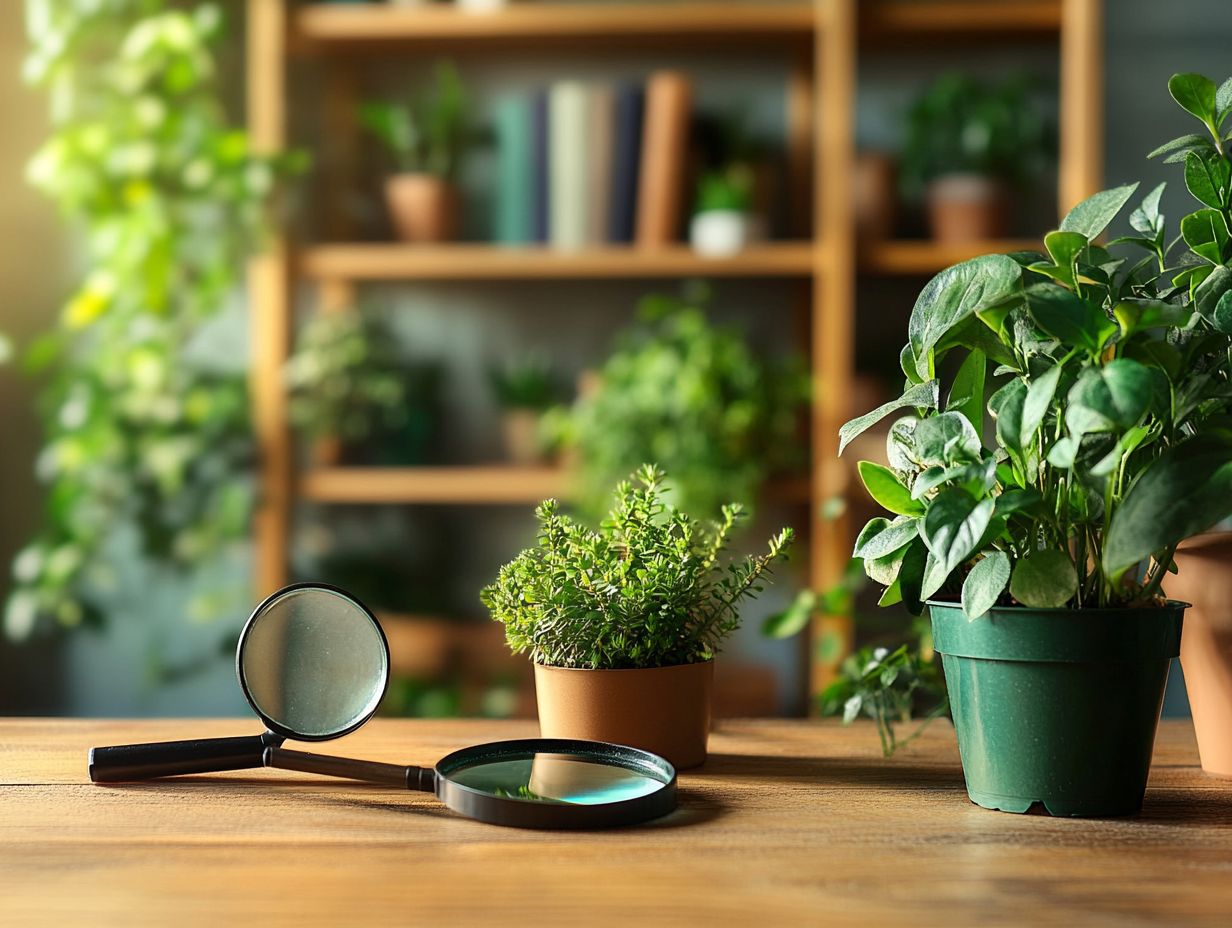
There are many myths surrounding indoor plant pests, but the top 10 include:
- All insects found on houseplants are harmful.
- Plant pests only affect certain types of plants.
- The best way to get rid of pests is by using pesticides.
- Indoor plants don’t attract pests.
- Overwatering plants prevents pests.
- Plant pests are only active during the summer months.
- Natural remedies are always the most effective for pest control.
- Pests can be easily identified by their appearance.
- Indoor plants can’t die from pest infestations.
- Pests only come from bringing new plants into the home.
2. Are all insects found on houseplants harmful?
No, not all insects found on houseplants are harmful. While some insects can cause damage to plants, others are actually beneficial and can help control pest populations. It’s important to properly identify the insects on your plants before assuming they are all harmful and taking action.
3. Do plant pests only affect certain types of plants?
No, plant pests can affect a wide range of plant species. While some pests may have a preference for certain plants, they can still infest and cause damage to other types of plants. It’s important to regularly check all of your indoor plants for pests, regardless of their species.
4. Is using pesticides the best way to get rid of plant pests?
Not necessarily. While pesticides can be effective in eliminating some plant pests, they can also be harmful to beneficial insects, pets, and humans. It’s important to consider other, more natural methods of pest control before resorting to pesticides.
5. Do indoor plants not attract pests?
Unfortunately, indoor plants can attract pests just as much as outdoor plants. Some common ways pests can enter your home and infest your plants include open windows and doors, bringing new plants into the home, or even on your clothing after spending time outside.
6. Can overwatering plants prevent pests and promote pest awareness?
No, overwatering plants can actually create a more favorable environment for pests. Excess moisture can attract and promote the growth of pests, such as fungus gnats and root rot. It’s important to properly water your plants and allow the soil to dry out between waterings to prevent pest infestations.

